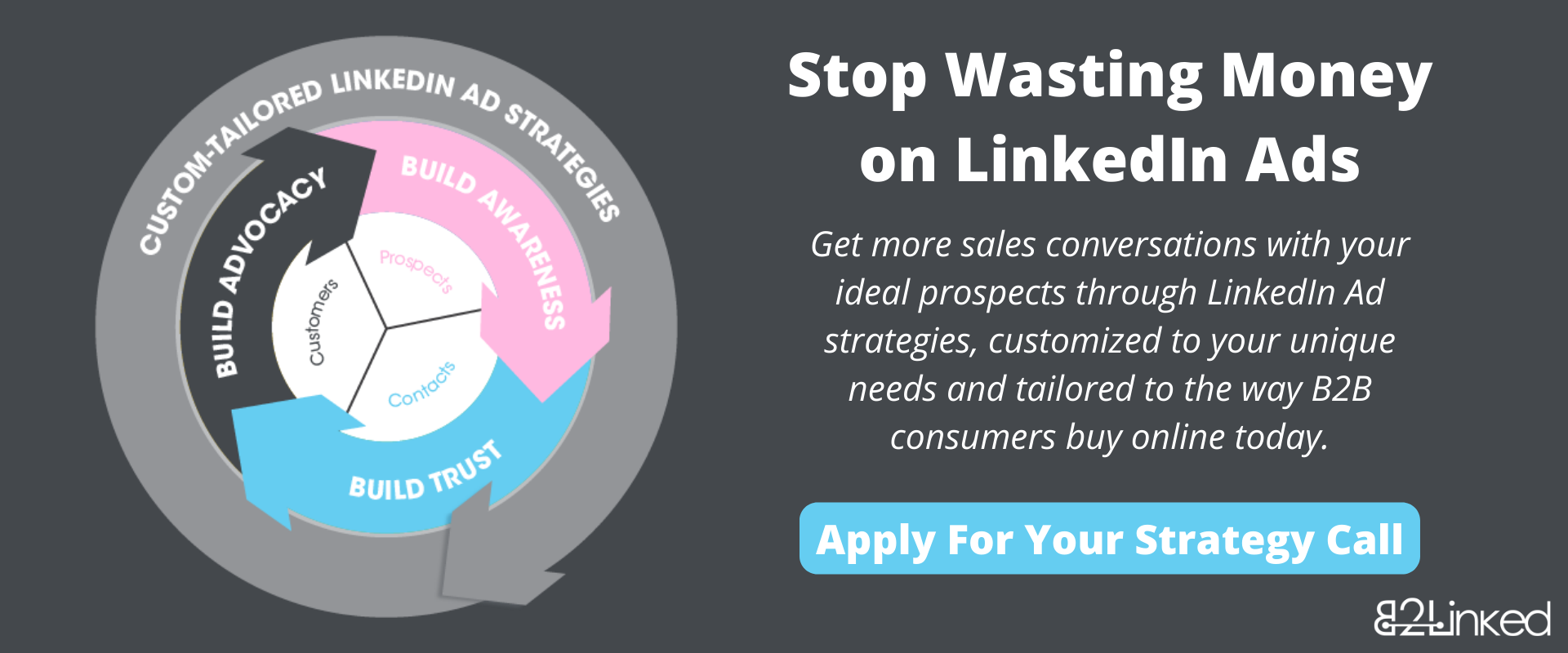
Best Practices for LinkedIn Ads Boosted Posts | How to Boost a Post on LinkedIn Ads


We’ve recently been getting a lot of people asking us about boosting posts on LinkedIn Ads—How do you boost a post? What are the best practices for boosting a post?
We gave a pretty good introduction to boosted posts in an episode of The LinkedIn Ads Show, so go check it out. For this post, however, we’d love to dive a little deeper and answer these two questions that we’ve posed.
If you yourself are wanting to learn more about this LinkedIn Ads feature, well then, you’ve come to the right blog post. Let’s hit it! 🚀
WHAT IS A BOOSTED POST?
First off, let’s quickly define what a boosted post is. Simply put, a boosted post is a piece of content that has previously been published to your LinkedIn company page, but is now being sponsored as an ad. And that’s the gist of it!
WHEN TO BOOST A POST
Now, when deciding whether or not to boost a post or just create an ad from scratch, there are some things to keep in mind.
SELECTING A POST TO BOOST
When choosing a post to boost, you ultimately want to pick a post that communicates the message you want to share with your target audience. Keep in mind the stage of the customer journey your audience is in.
If you’re targeting a cold audience, you’ll likely want the messaging in your post to be more top-of-funnel, focused on education and adding value. Maybe your post is a video that offers helpful tips for how your audience can do their jobs better or relieves a major pain point.
Aside from considering the message of your post, as a best practice, the more social proof you have on your post, the better. Social proof can be reactions, comments, and shares.
For those of us in content creation and management, that first like or comment is always the hardest to get. But the more engagement you receive, the easier it is for content to create a snowball effect. So boosting a post that already has a lot of engagement starts you off strong and is only amplified as you extend your reach to more people.
The third thing to consider when selecting a post to boost, however, is that your post needs to match your campaign objective and ad format. Which brings us to our next point…
SELECTING AN OBJECTIVE AND AD FORMAT
Say you want to drive people to your website from your boosted post. There are two things you’d need to do in order to make that happen:
(1) Your post would need to have a link that redirects them to your site and (2) your campaign objective would need to be one that supports driving website traffic, such as Website Visits or Engagement.
For example, if your campaign objective was Website Visits but your post didn’t have a link in it, then the post wouldn’t be eligible for boosting.
In another case, if you wanted to boost a video, but the ad format you selected when creating your LinkedIn Ads campaign was Single Image Ads, your video post wouldn’t be eligible to run under this campaign.
So, to reiterate again, when boosting a post, make sure that the type of post you want to boost also matches your campaign objective and ad format.
PROS AND CONS OF BOOSTING POSTS
Weighing the pros and cons can also be helpful in deciding whether to boost a post.
One reason you might want to boost a post goes back to a point we made earlier, which is that boosting a post preserves your social proof. We often associate people with highly engaging content as reliable, trustworthy, and credible. When we see posts with thousands of reactions and hundreds of positive comments, we’re inclined to trust the publisher.
Boosting content with a high volume of social proof, then, is a good way of quickly building trust with your target audience.
Another pro is that you can boost animated GIFs (this doesn’t even have to be done under the Video Ad format). The reason why this is such a big deal is because you can’t use GIFs when creating a normal LinkedIn Ad.
Even if you use an animated GIF when creating a Video Ad, the GIF will end after its first playthrough, rather than looping. GIFs can be a great way to capture your audience’s attention because there’s constant movement on a loop. So if you want an easy way to draw eyes to your ad, boosting GIFs is a good option.
On the flipside, boosting a post can muddy and limit tracking. Because you’re sponsoring content that lives on your LinkedIn company page, you can generate conversions from both (1) those who saw and clicked organically and (2) those who saw and clicked your post while it was being sponsored. The problem is it becomes a lot trickier to figure out which prospects came from your organic post versus your boosted post.
The way LinkedIn’s algorithm works also presents some challenges for tracking through boosted posts. Building a high volume of social proof on a post can be a huge upside when your post is being seen by those within your target audience.
The problem that arises, though, is that LinkedIn shares content within the networks of those who engage with that content. So you have the potential here for your post to be displayed to those who are outside your ideal customer persona (ICP), but it’s worth noting that the impact here is pretty minimal. Just don’t be surprised if you see unqualified people seeing, clicking, and converting on your boosted posts.
In addition, you miss out on specific UTM tracking when boosting a post. If you’re sponsoring the same post in multiple campaigns, for example, you can’t see down to the specific campaign a prospect, lead, or closed-won deal came from.
A potential workaround for this is by using a third-party URL shortener. The strategy behind this is that, when you include a shortened link in your post, you can change your landing page URL on the backend after a meaningful amount of time, so that it contains UTM parameters that communicate that your traffic was from an ad versus an organic post. This workaround does merit some precaution, though, as your redirect will cause a delay in page load speed, which could cause prospects to bounce before the page even loads.
In the near future (hopefully sometime in 2023), LinkedIn does plan to roll out a dynamic UTM feature when running ads. So this may not be an issue in the future, but it’s worth giving the precaution now while we wait for this functionality.
All of this said, if you’re on the fence about whether you should boost a post or not, consider which of these things you care most about. Do you value the option of quickly building trust with your target audience through social proof or having more accurate tracking?

HOW TO BOOST A POST
There are two ways to boost a post: The first is directly from your LinkedIn company page and the second is from within Campaign Manager.
BOOSTING FROM YOUR LINKEDIN COMPANY PAGE
The first option is simple enough.
Go to your LinkedIn company page and scroll down to the post you want to boost. Then click the “Boost” button in the top right corner of the post.

LinkedIn then takes you to a page where you can select your campaign objective, define your target audience, and set your budget, not unlike the experience you get when creating a campaign in Campaign Manager, though it’s very basic and a little limiting in comparison.

Once finished, scroll down to the bottom and click “Boost”. This will create a campaign in Campaign Manager where you can manage and monitor your newly boosted post.
BOOSTING FROM CAMPAIGN MANAGER
This second option is slightly more complex, but between the two, it’s the option we recommend because you have a lot more control and a broader variety of targeting/campaign creating capabilities.
Really, the boosting part is quite easy. It’s the campaign creation portion that’s a bit more complex. We won’t go through those details in this post, but you can find a full walkthrough on how to create a LinkedIn Ads campaign here.
Once you’ve set up your campaign, you’re ready to start boosting posts. When editing your campaign, click either “Set up Ads” in the left-hand navigation bar or scroll down and click “Next”

From here, click the “Browse Existing Content” button in the top right. You’ll then be able to view all eligible content to boost under your selected campaign objective and ad format.
Find the post you want to boost, click the checkbox next to it on the left, and click the “Sponsor” button in the bottom left.

And that’s it! Remember that, if your campaign is still in Draft, activate it by clicking “Next” and then “Launch Campaign”.
CONCLUSION
Boosting posts can be a great way to build trust with your target audience and run ads that appear more natural and engaging. We hope this article answered all your burning questions about boosted posts, how to do it, and how to do it well!
Is there anything we missed? What successes have you seen from boosting posts on LinkedIn Ads? Comment below!
And if you want to jump into the channel but don’t have the time or expertise to do it yourself, consider booking a discovery call with us.
We’ll build, execute, and manage a holistic, custom-tailored LinkedIn Ads strategy for you to help you get more sales opportunities with your ideal prospects.
Written by Eric Jones
